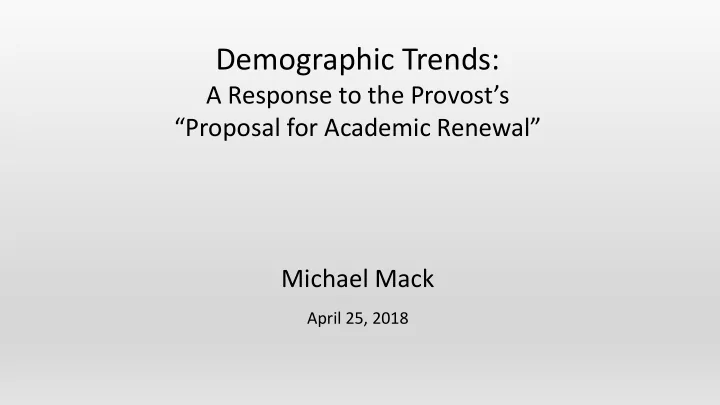

Does it matter that the Provost fails to mention that the number of schools like ours has actually grown over the period reported in the article (2009-10 to 2016-17)?
Does it matter that the Provost does not bother to consult the primary source but instead relies exclusively on reporting in the media?
Does it matter that the Provost misrepresented research?
Should the Provost be using scare tactics?
What agenda would drive the Provost to employ research in order to mislead his own faculty?
And the Provost’s third point
The article in the Chronicle
And the announcement it covers
The first paragraph of the announcement. The Provost’s quotation makes the situation sound not only dire but also long-term. However, the rating reflects “expectations for fundamental business conditions over the next 12- 18 months.”
Moody’s also states conditions that would lead them to upgrade higher education even before 12-18 months pass.
Moody’s projects net tuition revenue growth of 3% to 3.5% for private universities. Not only did we not hit 3%, our revenue growth was negative.
The Chronicle article notes the history of Moody’s rating of higher education. A “negative” rating was assigned in 2013. The sector received an upgrade to “stable” in 2015. Then in 2017 Moody’s issued a downgrade.
Here is Moody’s announcement when it upgraded higher education to “stable.”
Here is Moody’s affirmation of the “stable” rating in July 2016.
Does it matter that Moody’s outlook is only for a period of 12 to 18 months?
Does it matter that the Provost suppresses that fact?
Some questions pertaining to the Provost’s External Background section as a whole.
Does it matter that in each of his bullet points, the Provost suppresses data and essential interpretive context?
Does it matter that the Provost misrepresents research to advance his own agenda?
Does it matter that as a member of the faculty, the Provost is responsible for upholding the University’s standards for academic integrity?
Does it matter that as the chief academic officer of the University, the Provost is the ultimate authority for enforcing the University’s standards for academic integrity?
Does it matter that the Provost’s handling of research is at best grossly incompetent?
3. Other Independent Research
In addition to the curious omissions from the cited sources, there are odd omissions from the universe of available data.
As long as we are citing Moody’s…
While the competition has revenue growth of 3%, we have a decline of 5%. Damn those demographics.
The full report from Moody’s on CUA makes our troubles quite clear.
Chart from Moody’s. CUA’s rapid decline in cash flow margins should scare us.
As should every every line on this table — including Investments (what the market gives it can take away).
Here is where the alarm bells should really be going off. Not only are enrollments flat to declining, our discount rate is going through the roof.
Now for the Provost’s most curious omission of all…
Download your very own copy at https://nces.ed.gov/pubs2018/20180 19.pdf. Your tax dollars made this possible.
Every university receiving Title IV funding is required by law to submit data multiple times each year to the NCES via its Integrated Postsecondary Education Data System (IPEDS).
IPEDS is the definitive repository for data on higher education.
It is where every Institutional Research professional at every university in the country goes virtually every day.
And like WICHE, they publish projections.
Quick survey: Where should CUA go for its data on higher education? A. Western Interstate Commission on Higher Education B. The United States Department of Education’s National Center for Education Statistics
Like WICHE, NCES publishes projections for high school graduations.
From Projections of Education Statistics to 2026 . Published just this month.
Last year’s edition— the one available to the Provost, if he had chosen to use it.
Since not all high school students go to college, and since their decisions take into account many factors, including economic conditions. . .
Changes in the number of high school graduates do not necessarily correspond to changes in the number of students moving on to college.
Recommend
More recommend